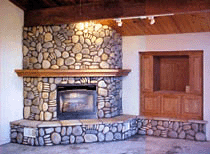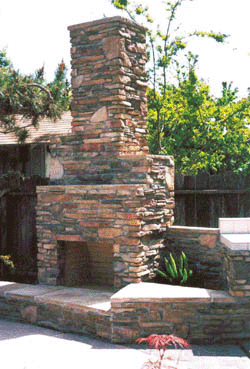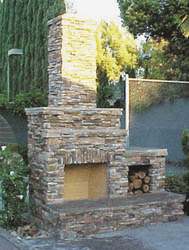How to Save Time & Money in Fireplace Masonry
By Masonry
 Fireplaces are no longer an add-on; they have become a standard part of the architect's residential ? and even commercial-design. Mason contractors can benefit from this in many ways.
Fireplaces are no longer an add-on; they have become a standard part of the architect's residential ? and even commercial-design. Mason contractors can benefit from this in many ways.
When second-generation mason Greg Tidwell started Tidwell Enterprises 17 years ago, most of the fireplaces he built were made of brick. Since that time, the Modesto, Calif.,-based company has seen a significant shift from brick to the use of manufactured stone. Tidwell's 60-employee company works primarily with high-volume production homebuilders in the region and installs about 300 fireplaces a month, some of which are faced with brick, natural stone or manufactured stone.
"When I first started in this business, about 70 percent of the masonry fireplace jobs were brick, 25 percent manufactured stone and five percent real stone," recalls Tidwell. "Today that has flip-flopped. Now we're doing about 70 percent manufactured stone, 25 percent brick and five percent natural stone."
Tidwell sees a number of factors that have influenced the popularity of manufactured stone. First is the product itself. "Since the '70s and '80s, the product has really changed. It looks much more believable," he says. "The manufacturers' design and engineering work has paid off. Today, it's hard to tell the difference between manufactured and real stone."
He notes that each of the executive offices in his building has a fireplace with a manufactured stone face. Customers often come in, point to the fireplace and say, "I want a stone fireplace like that one," not realizing it's made of manufactured stone.
Another significant factor in the increased use of manufactured stone, Tidwell believes, is the cost. "If you're doing a high-end custom home, the owners may insist on real stone, but in production homes, architects must stay within a certain budget and are more likely to use manufactured stone."
Tidwell estimates that a fireplace faced with manufactured stone costs at least 25 percent less for materials and labor. For an average-size fireplace, eight-feet high by six-feet wide, a natural stone fireplace would run about $1,900 to $2,000, whereas the same fireplace using manufactured stone would cost $1,100 to $1,200.
Saving time is another major reason architects and builders are gravitating toward manufactured stone. Tidwell gives an example of a 12-foot-high fireplace, "Using natural stone, a crew can lay up about four feet per day. Then they need to let it cure overnight before doing the next four feet. The full project would take three days. With manufactured stone, there is no cure time required so the job can be completed in one day. That's a huge difference ? a big savings."
Because manufactured stone doesn't require a footing, architects are finding additional uses for it. "Since you don't have weight restrictions with manufactured stone, it works in a lot more applications," Tidwell acknowledges. For example, manufactured stone used on the side of kitchen counters and on second floor fireplaces that wouldn't hold the weight of a genuine stone or brick fireplace. In California, another popular use of manufactured stone is in outdoor grills and patio fireplaces that add ambiance to backyard entertaining. "Because manufactured stone is so user friendly, we're seeing uses that we previously wouldn't have seen in production homes," he comments.
Commercial Applications
 Residential masons aren't the only ones using more manufactured stone. Jim Dayton, owner of Dayton Masonry in suburban Las Vegas, does between $8 million and $10 million of masonry each year, primarily commercial work. His company has 65 employees who create everything from fireplaces to high-end casinos, resorts and spas. This year the company received the 2002 Tucker Award from the Building Stone Institute for the Best Landscape Stone Application in a Residential Setting and a 2002 award from the Bricklayers and Allied Craftworkers for Real Stone Applications.
Residential masons aren't the only ones using more manufactured stone. Jim Dayton, owner of Dayton Masonry in suburban Las Vegas, does between $8 million and $10 million of masonry each year, primarily commercial work. His company has 65 employees who create everything from fireplaces to high-end casinos, resorts and spas. This year the company received the 2002 Tucker Award from the Building Stone Institute for the Best Landscape Stone Application in a Residential Setting and a 2002 award from the Bricklayers and Allied Craftworkers for Real Stone Applications.
Like Tidwell, Dayton has seen a gradual acceptance of manufactured stone in the commercial building industry during the 22 years he's been in business. "Manufactured stone is now widely accepted in the commercial construction genre." Dayton says. "Previously, it was viewed by most as a homeowner-type product."
Today, 60 percent of Dayton's jobs use manufactured stone, compared to 40 percent for natural stone. Dayton, too, credits much of that to improvement in the quality of the product. "Manufactured stone has been around for more than 30 years, but over the last few years we've seen a real concentration on research and development and work on replicating that real stone appearance."
Equally important is the application of the product. "We can make manufactured stone look as good as it gets," Dayton explains. "I tell my guys, 'pretend it's real.' I want it applied as if we were installing real stone."
He says it takes more than a realistic looking product to make manufactured stone look like natural stone; it takes great masons. "These guys work with real stone, so they know what it's supposed to look like when it's finished. For a convincing look, the bond, the layout, the size and the tooling of joints must be the same for manufactured stone as for natural stone."
Comparing cost, Dayton says that his company's average cost per square foot installed is between $20 and $35 for natural stone and between $17 and $22 for manufactured stone. "Cost is a driving factor on any construction job ? even more so on commercial. So if the job is budget driven and there's a tight time deadline, manufactured stone is going to win every time because it costs less and takes less time to put on."
Dayton claims that if the quality control on a project is good, the average consumer won't be able to tell whether it's natural stone or manufactured stone. "I'm a union mason contractor and the stone on my house is Southern Ledgestone from Cultured Stone," Dayton admits. "If you had told me five years ago that I'd have manufactured stone on my house, I'd have said you were crazy. But, to me, the difference in the look didn't warrant the increased cost."
A Growing Industry
 As demand for manufactured stone increases in both residential and commercial construction, so do the choices of patterns and textures. "When we first started making manufactured stone in 1962, the number of textures was very limited. Today we have more than 90 colors and textures available," says Bob Heath, vice president of marketing for Cultured Stone, Napa, Calif. ? considered the world's largest producer of manufactured stone. Heath says Cultured Stone products are made from natural ingredients including Portland cement and lightweight natural aggregates and are created by casting molds of natural stones, hand-colored with iron oxide pigments.
As demand for manufactured stone increases in both residential and commercial construction, so do the choices of patterns and textures. "When we first started making manufactured stone in 1962, the number of textures was very limited. Today we have more than 90 colors and textures available," says Bob Heath, vice president of marketing for Cultured Stone, Napa, Calif. ? considered the world's largest producer of manufactured stone. Heath says Cultured Stone products are made from natural ingredients including Portland cement and lightweight natural aggregates and are created by casting molds of natural stones, hand-colored with iron oxide pigments.
In response to the growing popularity of manufactured stone on fireplaces, the company recently released an interactive CD-ROM called Fireplace Design Solutions to help designers, masonry contractors, and builders to design and estimate manufactured stone fireplaces. The program leads users through a process that encompasses virtually every fireplace design element and provides photo-realistic images of the fireplace they created. It even estimates the quantity of material needed for each type of manufactured stone selected.
"There are literally millions of fireplace designs possible using the CD because users can match dozens of different styles with more than 90 stone texture and color combinations," Heath explains. He sees a bright future for the industry as manufactured stone products continue to gain acceptance in both residential and commercial markets.
About the Author
Masonry, the official publication of the Mason Contractors Association of America, covers every aspect of the mason contractor profession - equipment and techniques, building codes and standards, business planning, promoting your business, legal issues and more. Read or subscribe to Masonry magazine at www.masonrymagazine.com.


















